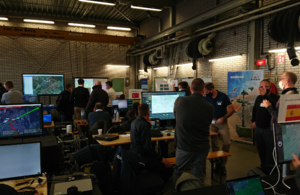Digitalization, defined as an enhanced connectedness and networking of digital technology to improve communications, services, trade between people, organizations, and things, was a challenge for the UN Global Sustainable Development Goals (SDGs). The digital world, which records, digitizes, and evaluates an increased scale of individual and communal activities to improve technology for the future, creates unique opportunities for enhancing future generations' social and digital welfare.
One crucial area to consider is the ecosystem of civic engagement –or, more simply, how the government provides information and services through technological partners. Modern government is increasingly relying on digital technologies to execute workflows with higher efficiency while making time for more high-value interactions and hence increased satisfaction for public services.
Rise of Technology in Civic Engagement
According to the World Economic Forum, decision-makers no longer ponder "why" they must involve civic engagement as an essential pillar of governance. But they are focussing on "how" to generate more awareness about civic engagement through digital governance. Some people see the civic sphere as a permanent element in their life, either through active access to resources or civic involvement.
Upon successful digitalization, citizens are enjoying a myriad of benefits, for instance:
- Users can tap into a more customized and smooth digital experience
- Citizens have to power to participate in the government’s decision-making processes
- The credibility of government procedures has increased manifolds
- Mitigated labor costs don’t let digital experiences come as a burden for users
This smooth transition from an analog government to a digital government has opened many doors for the citizens and they can treat technology in a better way. Civic participation has increased owing to its development in how governments assess their citizens' requirements and how the public is regarded as a participant rather than a participant recipient.
A closer look at Colombia’s electoral process showcases how blockchain technology plays a role in validating and authenticating electoral votes. Democracy Earth Foundation launched Plebiscito Digital (a digital voting platform) with which foreign-based Colombians could access their right to vote. This is indeed a revolutionary move for the citizens of any country; let’s wait for this technology to spread its wings throughout the world.
With Durham County Council’s acceptance of govService, citizens could practice their right for more choice and gain better insights about themselves with increased efficiency. This tremendous acceptance allowed the citizens to access more than 90 processes from the comfort of their homes. The contact channels have so far identified more than USD 308,000 in annual savings and as more people set foot into the digital space, these savings will rise with time.
The Paradigm Shift Towards E-Governance
The six major dimensions that are helping governments to shift focus and root themselves firmly in the environment of e-governance are:
- Digital Design - Re-engineering government practices to simplify and efficiently control the citizen-driven public sector irrespective of the channel used.
- Data-driven Public Sector - Focusing on data as the foundation stone to shape delivery, performance, and response to change according to the public sector.
- Openness - Transparency, integrity, and accountability go hand-in-hand, but outside involvement plays a significant role in building a functional governance culture.
- Public-Driven - Supporting the ambitions and allowing the public to communicate their needs without hassle.
- Government as a Platform - Developing a functional ecosystem to design effective technology policies that deliver high-end services.
- Proactiveness - Anticipating and rapidly responding to citizens upon the correct implementation of the above five dimensions.
The Pace of Adoption Across Geographies
With technology witnessing a boom in every sphere, the citizens are at the receiving end of benefits as most if not all processes focus on leveraging civic responsibility as the core. A German company named Merantrix has found a way to apply deep learning to medical imagining that will help in detecting lymph noted in the human body in every CT image.
The Cincinnati Fire Department is utilizing AI to improve urban service delivery that allows citizens to receive appropriate responses to medical emergency calls. AI systems analyze the type of call, location, weather, and similar calls to identify if a patient needs immediate on-site treatment or whether they should be rushed to the hospital. With this proactive approach, citizens are just one step away from receiving medical aid in no time.
Around 66% of American cities are investing in smart city technologies to make the lives of their inhabitants more smooth and worthy.
Challenges Associated with Digitalization
Citizens are considerably gaining more access to technology and digital governance procedures with time, but is digitalization the new dawn that we needed?
Democracy Earth Foundation launched Plebiscito Digital might’ve been a step ahead in revolutionizing the electoral process, but it is not void of challenges. The main challenges identified were:
- Immature blockchain technology
- Low digital skills among citizens
- Barriers of data as jurisdiction
- Resistance from political aspects
- Cultural barriers
Both the CDPI and Democracy Earth recognize that it is far from being a reality before the Blockchain elections can take place in Colombia and that it will be time for it to be formally adopted in others too. This example demonstrates, however, how a little effort may result in massive future developments.
Transparency and Data Privacy
Using consent models, governments can ensure that citizens control their information and trust the government to act in their best interests. While misinformation needs a multidimensional response to the competitiveness problem, public communications and public openness can allow citizens to bestow their trust in their governments. Tapping into civic interest through practical, honest communication, participatory techniques, and using novel platforms, such as social media, can lead to a more expanded and broad acceptance of digitalization among civic bodies.
According to OECD, governments can address and manage the risks associated with transparency and data privacy in public services. It highlights three messages:
- Although digital security concerns cannot be completely removed in a digital environment, the risk can be lowered to an acceptable degree, given the circumstances and economic targets at stake
- Digital security risk is not simply a technological problem but an economic and societal risk management challenge.
- Enterprises and other organizations should incorporate digital security risk management inside their economic and social decision-making processes.
Cost Efficiency and Feasibility
The feasibility and cost-efficiency of technological advancements in governance indeed highlight the strengths and weaknesses of a governing body.
- Technical Feasibility - Technical feasibility assists the government in recognizing the government's technology strengths and weaknesses to implement cloud-based e-governance.
- Financial Feasibility - Financial feasibility encourages the decision-making of whether or a method is financially viable for adoption. This analysis supports and backs cost-efficiency analysis.
- Organizational Feasibility - Organisational feasibility assists the government in determining if its structure is prepared to accommodate the new changes.
Conclusion
In addition to the cost issues, updating the conventional electronic government system takes a considerable time – the government manager of Microsoft UK, Richard Shipton, says: "You may traditionally look at a six-month or a year project to acquire and install more storage. You can accomplish that now by visiting the website and using your state procurement card."
The emphasis is to increase civic engagement and provide the citizen with added value, enabling government connections with citizens to change from repressive to a value-driven ecosystem. Governments must equip themselves with the skills, technology, and design necessary for change.






Comments